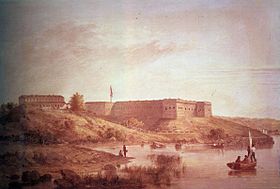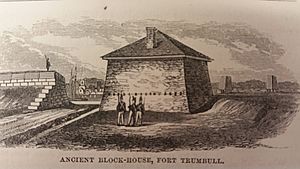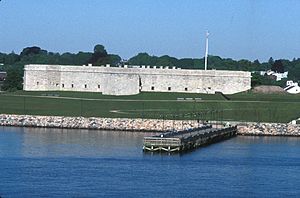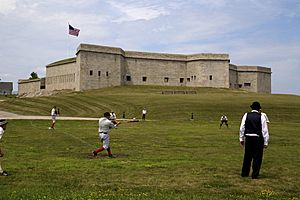Fort Trumbull facts for kids
Quick facts for kids Fort Trumbull State Park |
|||||||||||||||
|---|---|---|---|---|---|---|---|---|---|---|---|---|---|---|---|

Fort Trumbull facing Long Island Sound
|
|||||||||||||||
| Lua error in Module:Location_map at line 420: attempt to index field 'wikibase' (a nil value). | |||||||||||||||
| Location | New London, Connecticut, United States | ||||||||||||||
| Area | 17 acres (6.9 ha) | ||||||||||||||
| Elevation | 36 ft (11 m) | ||||||||||||||
| Established | 2000 | ||||||||||||||
| Administered by | Connecticut Department of Energy and Environmental Protection | ||||||||||||||
| Designation | Connecticut state park | ||||||||||||||
|
|||||||||||||||
Fort Trumbull is a large stone fort located near the Thames River in New London, Connecticut. Today, it is known as Fort Trumbull State Park and is managed by the Connecticut Department of Energy and Environmental Protection. The first fort was built here in 1777 and was named after Governor Jonathan Trumbull. The fort you see today was built much later, between 1839 and 1852. It is right next to the Coast Guard Station New London.
Contents
A Look Back at Fort Trumbull's History
In 1775, Governor Jonathan Trumbull suggested building a fort in New London. This fort would help protect the government of Connecticut. It was built on a rocky spot near where the Thames River meets Long Island Sound. The fort was finished in 1777 and named after Governor Trumbull.
The Attack by Benedict Arnold
In 1781, during the American Revolutionary War, the fort was attacked. Benedict Arnold, who had switched sides to join the British Army, led this attack. On September 6, 1781, British troops landed near the mouth of the Thames River. They marched towards Fort Trumbull in New London and Fort Griswold in Groton.
Fort Trumbull was captured after a short fight. However, about 150 Connecticut soldiers bravely defended Fort Griswold. After a tough battle, the British managed to enter Fort Griswold. The American commander, Lieutenant-Colonel William Ledyard, surrendered. Sadly, many American soldiers lost their lives during this event. After taking both forts, Arnold's troops set fire to New London before returning to their ships.
Fort Changes in the 1800s
Around 1808, the fort was repaired. Then, in 1812, it was rebuilt to meet new military needs. A small defense structure called a redoubt was first built to protect against British attacks. The fort we see today replaced the older one. It was built between 1839 and 1852. This new fort was five-sided and had four bastions. It could hold many cannons to defend the coast. Army engineer George Washington Cullum oversaw its construction. He later became the leader of the United States Military Academy at West Point, New York.
During the American Civil War, Fort Trumbull was an important place. It served as a training center for Union soldiers. New recruits were trained here before going off to war. For a short time, John F. Reynolds commanded Fort Trumbull. He later became a major general and died in the Battle of Gettysburg in 1863.
From 1863 to 1879, a soldier named Ordnance Sergeant Mark Wentworth Smith worked at Fort Trumbull. He also took care of Fort Griswold across the river. Sergeant Smith was a very old soldier for his time. He was born in 1803 and joined the Army in 1827. He was wounded in the Mexican War. He served until he died at age 76, making him the oldest enlisted man in the 19th-century U.S. Army.
Later in the 1800s, Fort Trumbull was updated. It was changed to hold larger, more modern cannons. Today, you can still see two of these large cannons in their firing positions.
Fort Trumbull in the 1900s
Home to the Coast Guard Academy
After the Civil War, Fort Trumbull received more modern artillery. In the early 1900s, new forts were built to protect Long Island Sound. Fort Trumbull became the main office for these forts. In 1910, it was given to the Revenue Cutter Service. This group later became the United States Coast Guard. The fort was used as the Revenue Cutter Academy, which changed its name to the United States Coast Guard Academy in 1915. The academy moved to its current location in 1932.
A Place for Learning
From 1939 to 1946, Fort Trumbull was a training school for Merchant Marine officers. These officers were vital during World War II. Over 15,000 officers trained here. One famous person who trained there was actor Jack Lord. He played Steve McGarrett in the TV show Hawaii Five-O. After the war, the University of Connecticut used the fort as a campus from 1946 to 1950. Many war veterans attended college there using the GI Bill.
Underwater Sound Research
During World War II, scientists at Fort Trumbull worked on sonar systems. Sonar helps detect objects underwater using sound. From 1946 to 1970, the fort was home to the Naval Underwater Sound Laboratory. This lab developed sonar systems for U.S. Navy submarines. In 1970, the lab joined with another center to form the Naval Underwater Systems Center. Work continued at Fort Trumbull until 1996. This marked the end of nearly 150 years of the fort serving as a military site.
Fort Trumbull State Park Today
After some rebuilding, Fort Trumbull opened as a state park in 2000. When you visit, you can see interesting displays and old cannons. Inside the fort, you can explore restored living areas from the 1800s. There's also a mock lab that looks like an office from the 1950s. The park has a large fishing pier and hosts concerts and other events. The main fort is open to everyone and even has an elevator to reach the upper parts.
See also





